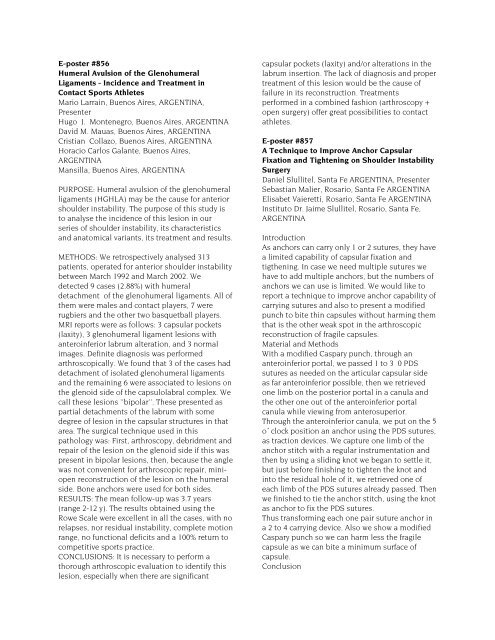POSTER ABSTRACTS - ISAKOS
POSTER ABSTRACTS - ISAKOS
POSTER ABSTRACTS - ISAKOS
You also want an ePaper? Increase the reach of your titles
YUMPU automatically turns print PDFs into web optimized ePapers that Google loves.
E-poster #856<br />
Humeral Avulsion of the Glenohumeral<br />
Ligaments - Incidence and Treatment in<br />
Contact Sports Athletes<br />
Mario Larrain, Buenos Aires, ARGENTINA,<br />
Presenter<br />
Hugo J. Montenegro, Buenos Aires, ARGENTINA<br />
David M. Mauas, Buenos Aires, ARGENTINA<br />
Cristian Collazo, Buenos Aires, ARGENTINA<br />
Horacio Carlos Galante, Buenos Aires,<br />
ARGENTINA<br />
Mansilla, Buenos Aires, ARGENTINA<br />
PURPOSE: Humeral avulsion of the glenohumeral<br />
ligaments (HGHLA) may be the cause for anterior<br />
shoulder instability. The purpose of this study is<br />
to analyse the incidence of this lesion in our<br />
series of shoulder instability, its characteristics<br />
and anatomical variants, its treatment and results.<br />
METHODS: We retrospectively analysed 313<br />
patients, operated for anterior shoulder instability<br />
between March 1992 and March 2002. We<br />
detected 9 cases (2.88%) with humeral<br />
detachment of the glenohumeral ligaments. All of<br />
them were males and contact players, 7 were<br />
rugbiers and the other two basquetball players.<br />
MRI reports were as follows: 3 capsular pockets<br />
(laxity), 3 glenohumeral ligament lesions with<br />
anteroinferior labrum alteration, and 3 normal<br />
images. Definite diagnosis was performed<br />
arthroscopically. We found that 3 of the cases had<br />
detachment of isolated glenohumeral ligaments<br />
and the remaining 6 were associated to lesions on<br />
the glenoid side of the capsulolabral complex. We<br />
call these lesions ''bipolar''. These presented as<br />
partial detachments of the labrum with some<br />
degree of lesion in the capsular structures in that<br />
area. The surgical technique used in this<br />
pathology was: First, arthroscopy, debridment and<br />
repair of the lesion on the glenoid side if this was<br />
present in bipolar lesions, then, because the angle<br />
was not convenient for arthroscopic repair, miniopen<br />
reconstruction of the lesion on the humeral<br />
side. Bone anchors were used for both sides.<br />
RESULTS: The mean follow-up was 3.7 years<br />
(range 2-12 y). The results obtained using the<br />
Rowe Scale were excellent in all the cases, with no<br />
relapses, nor residual instability, complete motion<br />
range, no functional deficits and a 100% return to<br />
competitive sports practice.<br />
CONCLUSIONS: It is necessary to perform a<br />
thorough arthroscopic evaluation to identify this<br />
lesion, especially when there are significant<br />
capsular pockets (laxity) and/or alterations in the<br />
labrum insertion. The lack of diagnosis and proper<br />
treatment of this lesion would be the cause of<br />
failure in its reconstruction. Treatments<br />
performed in a combined fashion (arthroscopy +<br />
open surgery) offer great possibilities to contact<br />
athletes.<br />
E-poster #857<br />
A Technique to Improve Anchor Capsular<br />
Fixation and Tightening on Shoulder Instability<br />
Surgery<br />
Daniel Slullitel, Santa Fe ARGENTINA, Presenter<br />
Sebastian Malier, Rosario, Santa Fe ARGENTINA<br />
Elisabet Vaieretti, Rosario, Santa Fe ARGENTINA<br />
Instituto Dr. Jaime Slullitel, Rosario, Santa Fe,<br />
ARGENTINA<br />
Introduction<br />
As anchors can carry only 1 or 2 sutures, they have<br />
a limited capability of capsular fixation and<br />
tigthening. In case we need multiple sutures we<br />
have to add multiple anchors, but the numbers of<br />
anchors we can use is limited. We would like to<br />
report a technique to improve anchor capability of<br />
carrying sutures and also to present a modified<br />
punch to bite thin capsules without harming them<br />
that is the other weak spot in the arthroscopic<br />
reconstruction of fragile capsules.<br />
Material and Methods<br />
With a modified Caspary punch, through an<br />
anteroinferior portal, we passed 1 to 3 0 PDS<br />
sutures as needed on the articular capsular side<br />
as far anteroinferior possible, then we retrieved<br />
one limb on the posterior portal in a canula and<br />
the other one out of the anteroinferior portal<br />
canula while viewing from anterosuperior.<br />
Through the anteroinferior canula, we put on the 5<br />
o´ clock position an anchor using the PDS sutures,<br />
as traction devices. We capture one limb of the<br />
anchor stitch with a regular instrumentation and<br />
then by using a sliding knot we began to settle it,<br />
but just before finishing to tighten the knot and<br />
into the residual hole of it, we retrieved one of<br />
each limb of the PDS sutures already passed. Then<br />
we finished to tie the anchor stitch, using the knot<br />
as anchor to fix the PDS sutures.<br />
Thus transforming each one pair suture anchor in<br />
a 2 to 4 carrying device. Also we show a modified<br />
Caspary punch so we can harm less the fragile<br />
capsule as we can bite a minimum surface of<br />
capsule.<br />
Conclusion
















